Selling Seasonal Products on Amazon to Maximize Profit Potential

Selling seasonal products on Amazon is more than just riding a wave. If your selling strategy is executed correctly it can be incredibly rewarding.
Selling seasonal products is about meeting the demands by planning the process effectively to prevent inventory overflow or giving evergreen products a seasonal twist.
You can capitalize on seasonal demands starting from aligning your catalog with the calendar.
In this article, we will elaborate on how to differentiate seasonal products from evergreen ones, strategies for seasonal inventory planning, pricing modulation for selling seasonal products on Amazon, and useful tools for selling seasonal products on Amazon.
We will also highlight different scopes of turning year-round products into seasonal products.
What are seasonal products?
To start selling seasonal products on Amazon you first need to understand what seasonal products are in the first place and how they are different from the rest.
Seasonal products are the products on Amazon that experience a surge in demand at specific times of the year. Deviating from perennial products that are consistently in demand, seasonal products are only sought after during festivals, holidays, or specific seasons.
For example, to better clarify the concept, here are some the examples of best seasonal products to sell:
- Holiday decorations: Lights and tree decorations during Christmas, Jack-o-lantern pumpkin buckets before Halloween, Easter bunny chocolates during Easter.
- Home decor items: Gardening items and outdoor furniture in spring, candles, and humidifiers as soon as the winter season sets in.
- Seasonal outfits and accessories: Furs, coats, boots in winter, cotton, swimwear, and flip-flops in summer.
Are seasonal products suitable for new Amazon sellers?
The success of selling seasonal products on Amazon is rooted in observing and acting on the demand cycle at the right time.
Planning and effectively managing inventory, and running PPC ads for a crowded marketplace like Amazon, all of it should be well-planned. This will strengthen the business execution leading to garnering maximum profit, with complete resilience of business to unplanned demand fluctuations.
So even if you’re a new Amazon seller, if you have the correct guidance of a seasoned Amazon marketing agency, consider your path to success clear!
What sets seasonal products apart from year-round products?
Let’s quickly take a look at how you can quickly differentiate between seasonal and year-round products:
| Factors | Seasonal Products | Year-Round Products |
|---|---|---|
| Demand Fluctuations | Demand spikes during particular seasons. | Demand remains consistent throughout the year. |
| Availability | Available for a shorter window due to sporadic demand. | Easily available throughout the year. |
| Marketing Strategies | Targeted campaigns specific to seasons’s needs or occasional hype. | Requires consistent marketing and promotional tactics for ongoing sales |
| Inventory Management | Requires careful planning to match seasonal peaks | Easier to manage with steady inventory levels |
| Consumer Behavior | Driven by urgency during peak times | Steady purchasing behavior |
How to determine if a product is seasonal for Amazon selling
By considering market trends, purchasing behavior, and seasonal demands, you can predict the popularity of the best seasonal products to sell. By closely observing the trend, and managing the inventory correctly, you can unlock massive opportunities as a seller.
But why not use some handy tools to get a clear understanding of the seasonal demand? These tools will help you mark the season’s arrival and lay a foundation for your seasonal selling strategy.
As a result, you can visualize the demand rising and stock up on your inventory right before the demand peaks.
Google Trends
A free open-to-all tool with a simple interface to understand changing patterns of trends according to search volume. It is one of the best-kept tips for selling seasonal products.
For example, say you have an Amazon electronics goods storefront, and you’re willing to sell seasonal products on Amazon due to the profit-making opportunities. You can go to Google Trends and search “Christmas lights”, then set your desired time frame; the spikes and dips will tell you when to keep your inventory ready, and when to start aggressive marketing strategies for the best returns.
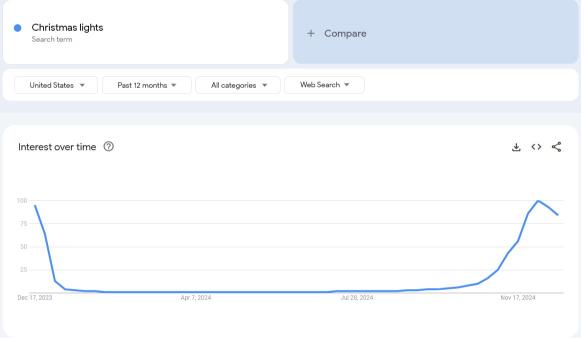
As you can see the rise in demand for Christmas lights from mid-November 2024. So, it implies that the inventory should be ready to match the pace of the growing demand from the start of November. Since it has no storage life, you can have your inventory ready from mid-October and run your PPC campaigns accordingly to not miss out on the initial spikes of orders.
Keepa
Pricing has a lot to do with the demand. So tracing the fluctuations in pricing can give a direct insight into the demands thus the best seasonal products to sell on Amazon.
Keepa gives a direct insight into how the prices change at different times of the year. That marks the demand surge and subsequently implementation of the data into compiling a catalog.
Why sell seasonal products?
While the demand for seasonal products is short-lived, there is a huge opportunity for Amazon sellers. Taking advantage of the influx of search volume for particular products can lead to big sales.
To capitalize on sporadic high demand
Be it changing weather or specific seasonal events, demands for certain products are meant to escalate during certain seasons. Amazon sellers can grab the chance and increase their revenue potential with the tips for selling seasonal products that we’re suggesting.
To get higher profit margins
Due to high demand, certain items can experience shortages at particular times of the year. Here Amazon sellers can deliver to the higher levels of requirement during peak season and with an increased price margin.
The reason is that during the season customers are willing to pay a higher price due to urgency. For example, if you’re maintaining a steady stock, you can meet their last-moment needs and charge a premium pricing for easy availability.
For enhanced brand visibility
Selling seasonal products on Amazon is more than just expecting profits; it offers you an opportunity to increase brand visibility.
During particular seasons when demand for certain objects rises organically, customers spend more time on Amazon searching for the correct fit. The demand increases so does relevance; so they are more prone to come across your products organically boosting the product’s visibility.
When this scope is properly leveraged by running seasonal campaigns, promotional offers, and discounts, you can easily convert customers. It increases the chances of customers returning for non seasonal items.
Faster turnover
Seasonal products have a quicker inventory turnover due to higher sales volume within a period of time. They are time-sensitive and this quick turnover ensures there is no need to pay long-term storage fees.
Take the example of Elf hats.
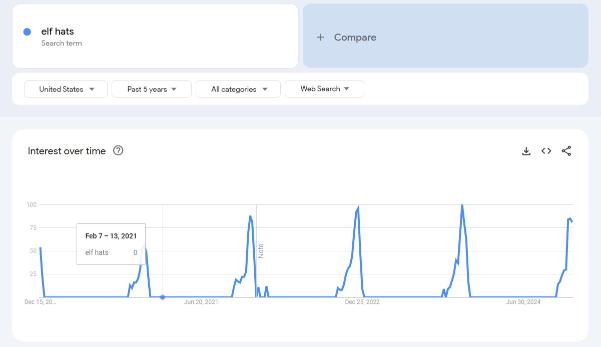
Google Trends has shown a quick spike and dip at the same time of the year in the past five years maintaining no searches throughout the rest of the year. With proper forecasting, it is possible to plan the inventory and pricing in a way that gets completely sold out with a minimum surplus.
Global selling potential
Amazon’s international marketplace allows you to tap into different markets and extend the lifespan of your seasonal products by selling across hemispheres with opposite seasons.
We will elaborate on this in our following segment.
What you’ve gathered from this till now with the tips for selling seasonal products is how crucial inventory management is for successfully selling seasonal products. In our next segment, we’ll take you through how to plan for a seasonal inventory and what tool to use.
Pricing and inventory planning for seasonal sales on Amazon
Strategic selling is a core requirement for successfully selling seasonal products on Amazon. It can include timely planning of promotions and delivery, monitoring inventory levels, and fine-tuning product prices to suit the demand.
Promotional strategies and their timing
Correct timing determines the level of success you can achieve via seasonal selling. Seasoned business owners will know the importance of each week before an event and how crucial it is to start promotional efforts before the demand reaches its peak. Timely promotions drive early sales. It works as a subtle nudge to stock up on seasonal essentials and it helps your Amazon store become the early bird who gets the sales and succeeds at selling seasonal products.
Take the seasonal sales of Halloween costumes for example. We can see Halloween posts on the internet for several weeks prior. While most of them are promotional posts endorsed by influencers, it pushes their followers to replicate their content and have their Halloween costume photo sessions as well.
This stirs up the need for more costume ideas and early availability. Most of the sellers of such fany costumes start running ads from the start of Autumn. If you leverage the retail arbitrage inventory planning and start planning your campaigns around the time Starbucks launches its Winter drinks, imagine how fun and festive it might feel for your customers! So if you’re wondering if this feel-good factor can drive some good sales, you’re correct.
Timing is equally important for stock-keeping just like promotions. If PPC ads are drawing attention towards item A, and your inventory is falling short of it, it is not only adding to reputation loss but a waste of ad budget as well. So inventory and PPC ads must work hand in hand to generate demand and maintain timely delivery.
Dynamic pricing to stay ahead
A dynamic pricing strategy is a boon for seasonal objects. The pricing strategy should follow a steady balance between demand, market, and inventory levels. You being a seller must be well-versed with the pricing progress according to seasons, discounted pricing strategy for end-of-season inventory clearance, etc.
Let’s take a look at some of the best practices of dynamic pricing (of course, with examples) on how to tune the dynamic pricing strategy for selling seasonal products on Amazon.
When practicing dynamic pricing the best way to start is to set hard limits on the prices so that the profit margin is not too low. Dynamic pricing that aims for a competitive approach, if implemented correctly can lead you to win the Buy Box.
Bundling for seasonal selling is a great idea. This encourages larger quantities of purchases at a more affordable price. For example, seller X can offer a set of streamers of three different designs at $24 while each set individually costs up to $10. Ultimately, resulting in more sales.
You can use scarcity pricing to raise the prices when the inventory is low and demand is high to land the best profits. For example, if the inventory drops to 30 units, and the demand is high at that point in time, you can increase the price by 15% from the current price.
Seasonal sellers often find the cost of inventory storage for the entire year higher than the cumulated profit margin. If not higher, they find it easier to fight overstocking with discounted pricing. To manage overstocking, you can also sell at a discounted price. But avoid a sharp discount as post-season pricing to keep up with the brand image.
Customers often respond well to ‘limited edition’ higher price anchors during the holiday season as they are inclined to be more generous with their expenses.
During festival rush hours sellers often gain good profit by hiking the price by around 30% for fast shipping. You can also hike your product prices minimally as they start ranking higher organically. On the contrary, you can bring down the prices minimally to accelerate the sales potential and consequently the position among search results. In the next segment, we will discuss how to implement pricing tools to automate price adjustments while selling seasonal products.
An alternate route of planning
Amazon sellers need to keep some alternative selling strategies handy to succeed in different situations. So that sellers can pivot to whatever strategy keeps the momentum going. Bundling options or alternative sales channels such as repurposing can be excellent alternative strategies during selling seasonal products.
Value addition via competitive pricing
Despite creating a price war, there are several other ways to be competitive in pricing strategies. Instead of monitoring and adjusting prices according to competitors, try adding special services, like fast shipping or free delivery to catch the attention. Seasonal product selling strategies revolve around offering customers an extra something to stand out among a myriad of similar products.
Easy escape from shipment-related issues
To ensure timely delivery we suggest you opt for Amazon FBA services for reliable delivery even during the demand surge. When you sell seasonal products on Amazon you can get your products delivered to the Amazon fulfillment centers before the season reaches its peak. Thus it doesn’t leave you in a position to face last-moment fulfillment issues or stockouts which simply translates to no missed sales opportunities, thus successful selling!
When should I start to launch seasonal products?
You can take your time and keep the inventory sufficient before the season officially arrives. Factor in the restock lead time to list the items at least a couple of months before the season arrives. Keep a keen eye on the subcategory movement and get a picture of when to stock and launch the products.
However, the trick to successful selling is to start running ads on time.
Seasonal sellers from our clientele usually start their ad campaign before 2-4 weeks (depending on the category) and it has resulted in a record of up to 100% increase in Seasonal Sales on Amazon when compared to its historical data.
Boost the relevance of evergreen products by including seasonal versions
By changing the packaging, product content, and marketing strategies, it is possible to change the views of the audience towards a product and create a seasonal product out of the year-round ones. Here we are sharing some tried and tested ways to turn your regular products into season’s specials.
Altered packaging for the seasonal appeal
There is a reason why brands come up with special holiday packaging every year during Christmas. They have recognized the fact that the jolly festive trope in packaging can help the brand gain better attention and stand out among all other competitors in the aisle.
We can easily notice the dominance of green and red in the packaging for Christmas and New Year’s whereas in summer we see an abundance of yellow, orange, or other tropical colors. It is one of the widely used seasonal product selling strategies.
Packaging is an excellent medium of communication that generates brand recognition and drives impulse buying to a great extent. So even evergreen products can get a seasonal boost just with a simple change of packaging.
Incorporating relevant seasonal keywords for better discoverability
Optimizing search ranking via keywords is the foundation of ecommerce businesses. Imagine how beneficial it can be for your business if you can leverage the relevant trending keywords to rank in searches during peak times!
But striking a correct balance between seasonal and evergreen keywords will make sure your products garner sales year-round while getting the peak-time Seasonal Sales on Amazon benefits.
For example, you can be a regular board game seller on Amazon and still make your products rank as a seasonal one by simply adding ‘board games for Christmas’ or ‘Christmas games for family party’ as backend keywords. Make use of specialized keyword research tools for Amazon.
Seasonal variations of evergreen products
New product development or product improvement is another major aspect of seasonal selling. You can get a complete understanding of high-demand products during a particular season using simple keyword research and that is how you figure out more about your seasonal offerings.
You can include these seasonal attributes in your best-selling products and sell is as a seasonal variation.
For example, an owner of a healthy snack brand may find a spike in the sales of gingerbread cookies during Christmas among several other options. He may use the Amazon PPC reports or even brand analytics reports to find his star product, which may be a certain sugar-free mini croissant.
They may include a gingerbread-flavored version of their mini croissants or expand across different market segments and sell it as a seasonal product.
Selling Seasonal Products Across Different Seasons
Selling seasonal products on Amazon opens up the path to exploring international markets so that there is no excessive inventory stock. This is because seasons vary across the globe— while Australia in the Southern Hemisphere experiences winter its summer in the U.S. This multiplies seasonal peaks for you to capitalize on.
So if you’re dealing in apparel, your fur coats and snow boots are going to be in demand all year round. It becomes an excellent scope for inventory recycling with Amazon being a global marketplace. This international selling strategy prevents excessive stock pileups and ensures the revenue is consistent throughout the year.
Tools for selling seasonal products on Amazon: SellerApp got you covered
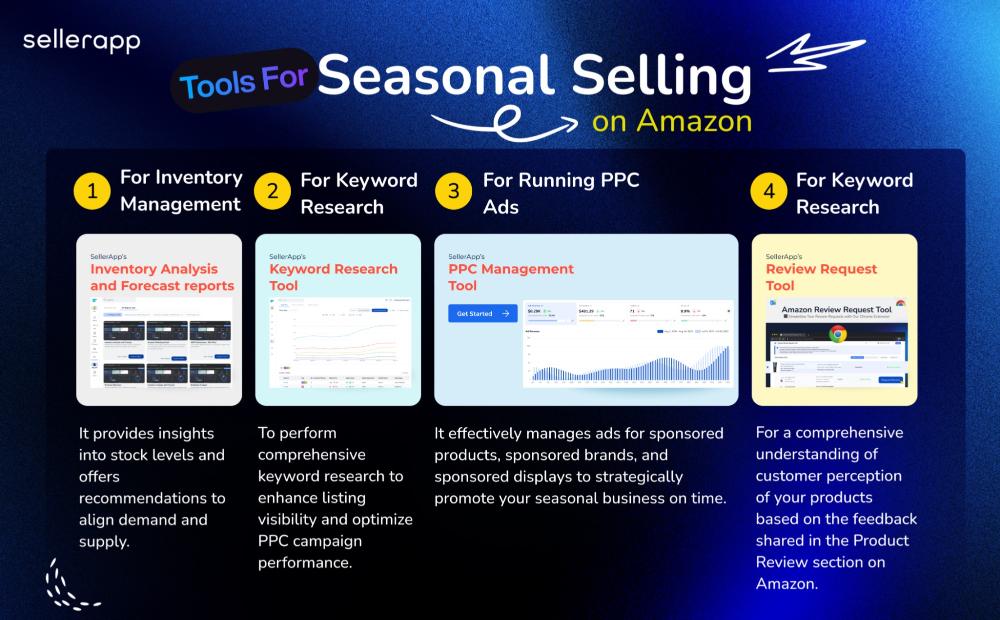
Making informed decisions is the best way to sell seasonal products on Amazon and make profits. That is why we suggest a set of tools as seasonal product selling strategies to make calculated decisions in your seasonal selling journey. At SellerApp we have it all—one dashboard, many tools to skyrocket selling seasonal products on Amazon.
Inventory management tools
To efficiently track stocks, forecast demand status, and optimize the entire inventory management process, we recommend the use of inventory management tools such as Sellbrite, Linnworks, etc. This will ensure the high volume of orders does not mess with the order fulfillment status.
Similarly, once you connect SellerApp’s Dashboard with Amazon Seller Central report, the Inventory Analysis and Forecast reports will give you a clear understanding of stock levels and subsequent suggestions regarding demand and supply.
Keyword research tools
You absolutely need to conduct in-depth keyword research to add better visibility to listings and run successful PPC campaigns. Use keyword research tools such as the one from SellerApp to identify the high-volume keywords. Simply go to the keyword research tool and add your main keyword at the search bar.
Say you plan to sell coffee on Amazon, add the word ‘coffee’ at the search bar and you get an elaborate list of phrase-match keywords that you can pick and choose for your listings.
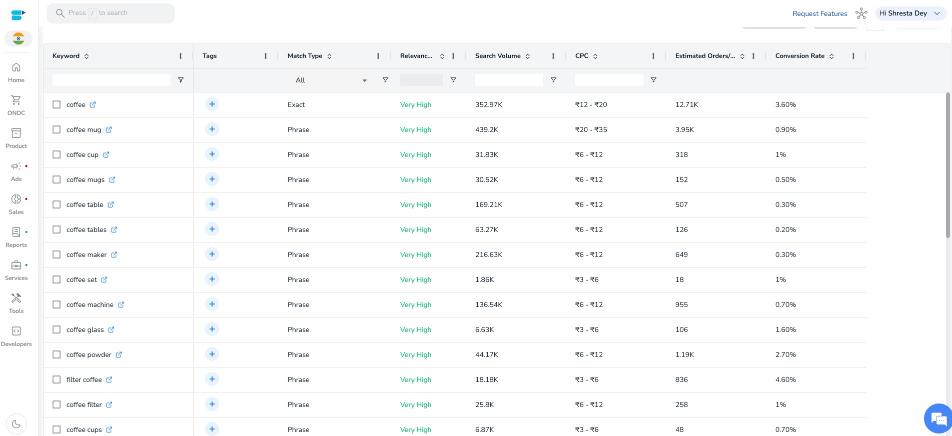
Advertising platforms
SellerApp’s PPC campaign tool can efficiently run ads for sponsored products, sponsored brands, and sponsored displays to promote your seasonal business timely. Our Amazon PPC experts will thoroughly analyze your products and suggest ad budgets and strategies keeping your goals and threshold in mind. Check out the details here.
Feedback and review management tools
It is extremely challenging to provide excellent customer service during the seasonal surge. Among other important tools, we suggest feedback and review management tools to monitor customers’ sentiments regarding fulfillment to better the services.
So, what’s the role of reviews in selling seasonal products?
Reviews play a crucial part in selling seasonal products on Amazon. This is because
- they help build trust with a sense of credibility,
- Amazon boosts listings with higher positive reviews and thus drives conversion, and
- creates a purchasing urgency due to a limited sales window.
Take the help of the SellerApp Sentiment Analysis Reports getting a detailed insight into customer perceptions through the feedback they leave in the Product Review section. Once you connect your SellerApp Account with your Amazon Seller Central account, this reads through the data and consolidates it to present a visualized report of customer feedback.
It looks somewhat like this.
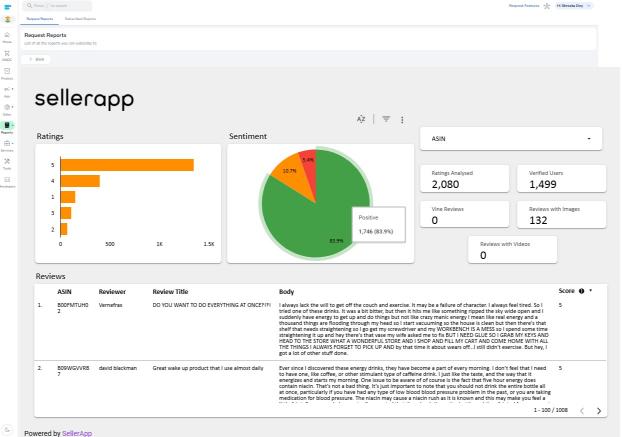
Final thoughts
Understanding the seasonality holds the biggest power. When we implement strategic selling, it gives us the best approach for harnessing seasonal demands. Always plan your seasonal selling strategy way ahead to make the most out of your efforts.
When planned meticulously leveraging the tools offered, it becomes a revenue booster for your product offerings. Planning and executing successful seasonal sales can be overwhelming. That’s where we, SellerApp come in with our wide range of Amazon PPC ad solutions and years of experience.
While we come up with strategies to make your products visible to your target customers, you can execute it reaping the benefits of successful seasonal selling. Book a call with us (for free!) if you want a clear action plan for incremental growth on Amazon.
Additional Readings:
Streamlining Amazon Order Management: Best Practices for Success
Top 8 Hacks to Increase Your Product Sales on Amazon and Maximize ROI
Cross Selling and Upselling on Amazon— Effective Strategies For Success
Amazon DSP Advertising Guide for Getting Increased Conversions
How To Get The Amazon Best Seller Badge – Seller Tips


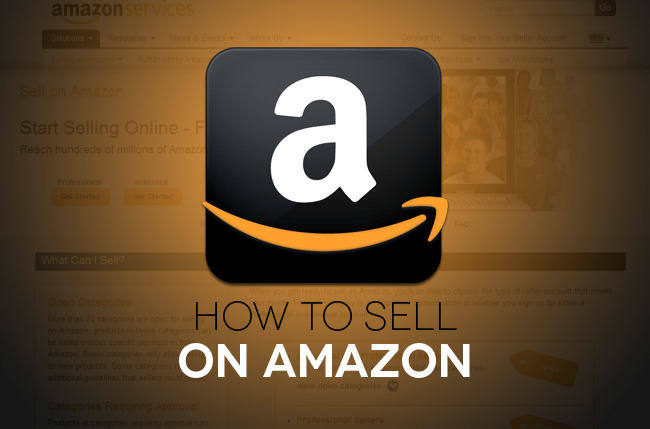


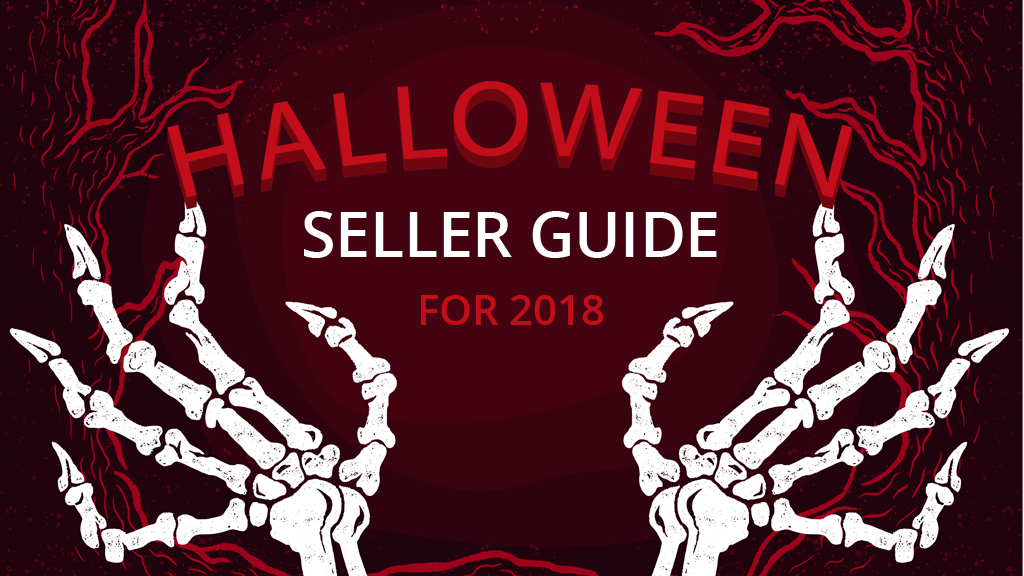
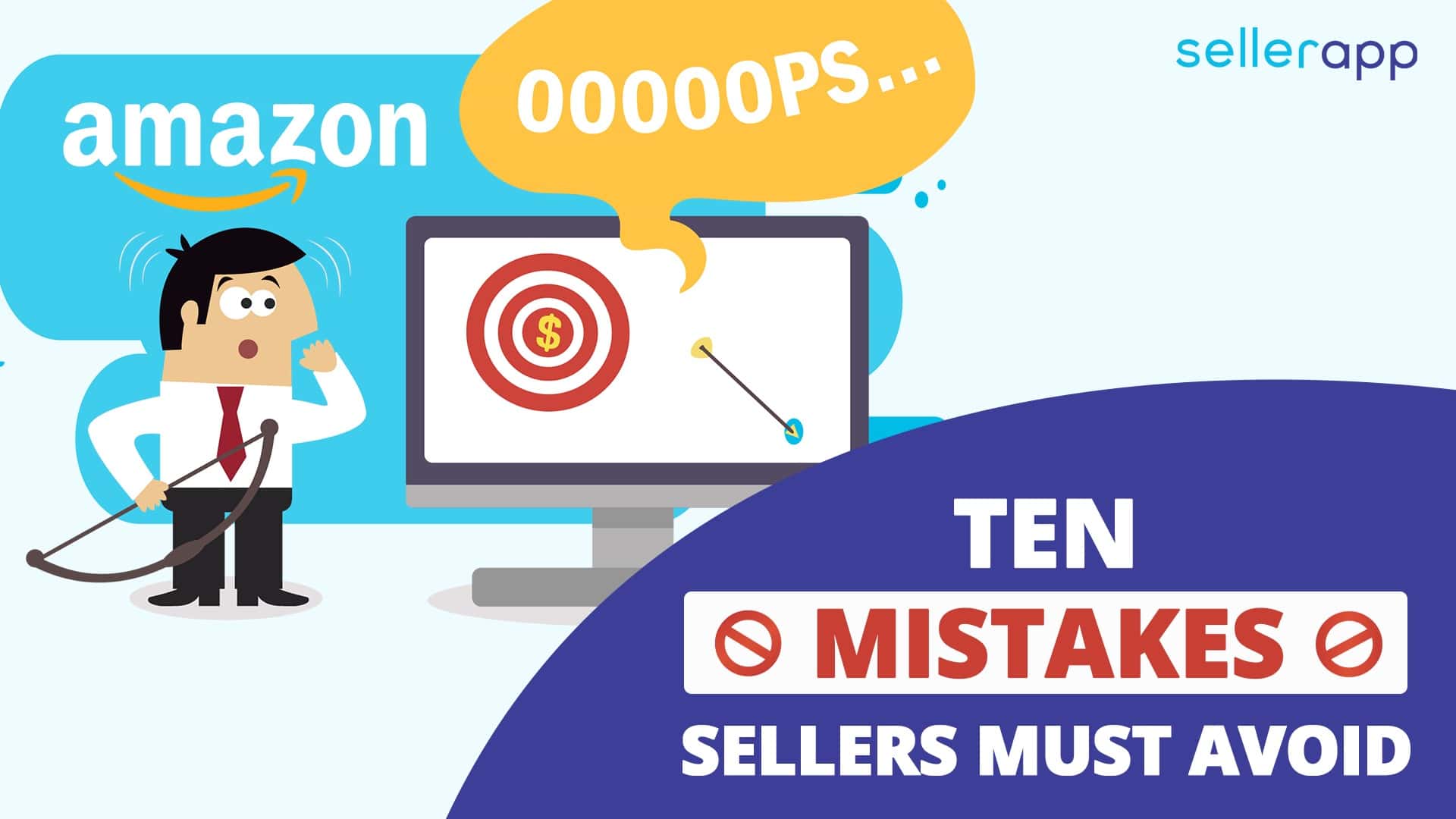




Patrick Mills
February 19, 2025Great insights on dynamic pricing and bundling strategies. It’s refreshing to see practical tips that even new sellers can easily implement.
Clare Thomas
March 27, 2025Thanks for the feedback! Easy implementation is key.